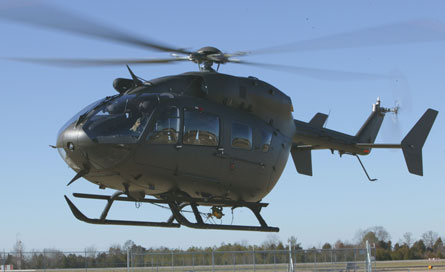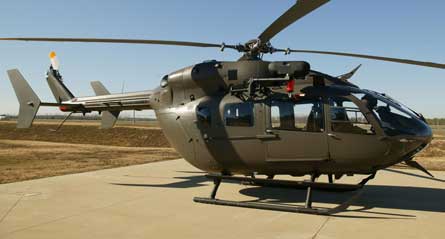Headlines can be scarce for healthy-looking acquisition programmes. The US Army's $2 billion plan to buy 322 light utility helicopters (LUHs) over the next decade offers a case in point.
Full-rate production came in September with barely a news media whisper, with contractor EADS actually delivering the first 10 UH-72A Lakotas ahead of schedule. Meanwhile, the LUH programme's troubled sister aircraft - the Bell Helicopter ARH-70 Arapaho - has dominated headlines with news of a flight test crash, technical problems and cost overruns.
 |
|---|
© EADS |
But, despite the disparity in coverage, the army's experiments with the LUH programme as a truly commercial-off-the-shelf acquisition and as a transplanted US production line means the UH-72A may have the most enduring impact in terms of US defence industry trends.
The UH-72A is a military copy of the FAA-certificated Eurocopter EC145. In 2004, the army decided to waive the requirement for a new aircraft designed to meet military specifications. The decision meant that the LUH could be fielded within a few years, avoiding the cost and schedule risks of developing and certificating a unique design.
"The requirement [for a civil type] was vetted through the army leadership and approved," says Randy Hutcherson, vice-president of rotorcraft for EADS North America Defence. "If they said, 'we're going to buy a COTS aircraft and modify it', [the schedule] certainly would have been much longer."
The trade-off is a limitation on the UH-72A's mission flexibility. The fleet is restricted to permissive environments, where the threat of hostile fire is highly unlikely. This makes the aircraft ideal for general utility and homeland defence missions, but prevents the fleet from being deployed.
 |
|---|
© EADS |
"If you're going to put soldiers in this aircraft in an environment where they're going to be shot at, our aircraft is not ready to do that and it's not the right thing to do for the soldiers," Hutcherson says. However, it remains possible that this part of the LUH experiment may not survive the duration of the programme. When asked if the army will eventually require a military-unique variant of the UH-72A for LUH, Hutcherson replies: "I do. But I think it's a ways away."
The second major experiment on LUH is EADS's plan to duplicate Eurocopter's production line at Donnauworth in Germany with a new manufacturing site in Mississippi. The programme's schedule makes the UH-72A the first US military aircraft to undergo transatlantic relocation.
AgustaWestland is standing up a final assembly site with Bell Helicopter for the VH-71A presidential helicopter for the US Marine Corps in Amarillo, Texas. Alenia Aeronautica also has plans to produce the C-27J Spartan transport for the army with Boeing in Jacksonville, Florida.
In this manner, LUH also serves as a proxy for a key claim by the Northrop Grumman/EADS team in the US Air Force KC-X tanker competition. The KC-30 team's proposal hinges on the ability to stand up a final assembly line for the Airbus A330-200 in Mobile, Alabama.
"Clearly, that's the real risk in the LUH programme right now," says Hutcherson. But John Burke, EADS's project manager for LUH, adds: "The risk of duplicating the production line is considerably less than ramping up a production line that never existed before."
The transition plan calls for EADS to stand up a production capability in three steps, starting with a "light assembly line" that switched on in September with the delivery of the 10th aircraft. This first step is limited to painting the airframe and installing the seats.
The next two steps will add a final assembly capability starting with aircraft 42 in the second quarter of 2008 and a full production line with aircraft 100 in 2009, Hutcherson says.
Mitigating the risk of production system delays or workforce shortfalls is the fallback of a running production line in Germany. "I can still continue to meet the army's requirements by building more aircraft in Germany than I have to," Hutcherson adds.
But the risk to the future of LUH is a two-way street. If the army has to worry about a transplanted production line keeping its delivery schedule on track, EADS may have to worry about the army's funding profile remaining in tact. The amount of LUH orders is decided by annual allotments of funding. But both LUH and the army aviation budget as a whole face increasing pressure over the next few years. Additional funds will be needed to pay to reset the fleets of aircraft and ground vehicles returning from operations in Iraq and Afghanistan.
The budget uncertainty may drive EADS to find additional customers for the new Mississippi plant. The company's strategy rests on securing new orders from foreign militaries and security services for the UH-72A, but other alternatives could be reviewed. Adding commercial orders to the US site's backlog could help fill the gap if the army's contract dries up.
In the worst case, Hutcherson says: "If we don't do something we've got a large empty building in Mississippi. Does it make sense to move more commercial orders to the US? It could. It depends on how many the army orders every year."
The ARH and LUH owe their existence to requirements to replace the army's ageing Bell types using funds diverted from the cancelled $14.6 billion Boeing Sikorsky RAH-66 Comanche programme. But there similarities end. The ARH-70 represents a fairly straightforward acquisition programme, but the army decided to use the UH-72A as a test case.
Source: Flight International























